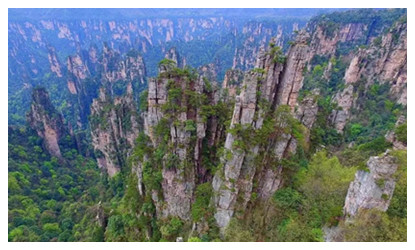- Home
- China Provinces Guide > Hunan > Hunan Travel Guide >
Hunan Geography
Hunan Province is located in the middle-by-south part of China along the middle reaches of the Yangtze River, called “Xiang” for short. Since most of it lies to the south of the Dongting Lake, it is therefore called Hu'nan. With the area of 210,000 kilometers, Hu'nan Province is divided into 13 provincially administered municipalities and 1autonomy, its capital is Changsha City.With abundant natural resources, the province covers 210,000 square kilometers (81,000 square miles). The province has a total population of 64,400,700. It is multiethnic, with Miao, Dong, and Yao being the most numerous minorities. Their unique cultures and ethnic customs attract numerous visitors.
Physical Features

Basically Hu'nan is positioned between the coastal opening up zone in Southern China and Yangtze Valley which adds to its geographical advantage. Surrounded by mountains and hills in the east, west and south, Hunan comprises of hills and basins in the center and plains in the north. The center and northern parts are a somewhat low and a U-shaped basin, open in the north and with Dongting Lake as its center.
The Northern part of Hu'nan backs on the Yangtze River and opposites Hubei Province, water transportation is convenient. It is within the opening up and developing zone in the middle and lower reaches of the Yangtze River. Yueyang City is located in north of Hunan Province as the North Gate of Hunan.
Southern Hu'nan borders Guangdong and Guangxi province, being adjacent to the coastal opening up zone, Hongkong and Macau, and a through container truck can reach Hongkong at the same day;
Eastern Hunan connects with Jiangxi Province.
Western Hunan Provicne borders Chongqing and Guizhou.
Hunan Climate
Hunan is located in a region with a continental subtropical seasonal humid climate with four distinct seasons. It has abundant sun, long frostless periods and abundant rain. The annual sunshine duration is 1300 to 1800 hours. The annual average temperature is between16℃-18℃. The frostless period is as long as 260-310 days. Annual rainfall is 1200-1700 mm, which is favorable for agricultural crops and green plants.
Rivers and Lakes In Hunan
Dongting Lake is the largest lake in the province and the second largest freshwater lake in China. Xiangjiang, Zijiang, Yuanjiang and Lishui Rivers are the four main tributaries of Yangtze River flowing through Hunan, and into Dongting Lake at Chenglingji, Yueyang.
Hunan has an extensive network of rivers, with a fresh water area covering 13,500 square kilometers. In the north lies Dongting Lake, the second largest freshwater lake in China. It has the largest reserve of natural water resources among the nine provinces of southern China. Xiangjiang, Zijiang, Yuanjiang and Lishui Rivers are the four main tributaries of Yangtze River flowing through Hunan, falling into Dongting Lake at Chenglingji, Yueyang.
Mountains In Hunan
Huping Mountain in Shimen County, Changde, Hunan's highest mountain, reaches an elevation of 2,009 meters, while its lowest area Huanggai Town in Yueyang is only 21 meters above sea level.
Natural Resources In Hunan
Hunan has abundant resources of animals and plants. Five rare surviving "living fossil" in the world are found in Hunan, namely: Cathaya Aargyrophylla, Met sequoia Glyptostrobodies, Glyptostrobus Pensilis, Gingko and Davidia Involucrate.
There are around 5,000 species of seed plants, ranking 7th across the country. There are more than 2,000 species of woody plants, 1,000 species of wild economic plants, and 800 species of medicinal plants. 55 species are identified as rare wild plants under the state protection, making up 17.7% of that throughout the country.
There are woody plants of 103 families, 478 genera and 2, 470 species. Hunan's forest coverage reached 59.57% by the end of 2015, higher than the national and world level. 22 national and 27 provincial natural conservation areas, and 126 forest parks, have been established, and the first national forest park
Zhangjiajie Forest Park is among them.
Hunan has a great variety of animals. There are 66 kinds of wild mammals, over 500 sorts of birds, 71 kinds of reptiles, 40 types of amphibians, more than 1,000 sorts of insects and over 200 kinds of aquatic animals. There are 18 categories of animals under the first-class state protection,.

 Basically Hu'nan is positioned between the coastal opening up zone in Southern China and Yangtze Valley which adds to its geographical advantage. Surrounded by mountains and hills in the east, west and south, Hunan comprises of hills and basins in the center and plains in the north. The center and northern parts are a somewhat low and a U-shaped basin, open in the north and with Dongting Lake as its center.
Basically Hu'nan is positioned between the coastal opening up zone in Southern China and Yangtze Valley which adds to its geographical advantage. Surrounded by mountains and hills in the east, west and south, Hunan comprises of hills and basins in the center and plains in the north. The center and northern parts are a somewhat low and a U-shaped basin, open in the north and with Dongting Lake as its center. Ask Questions ?
Ask Questions ?